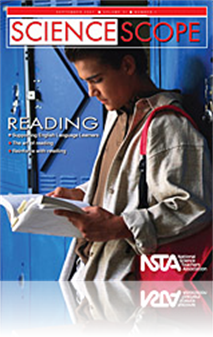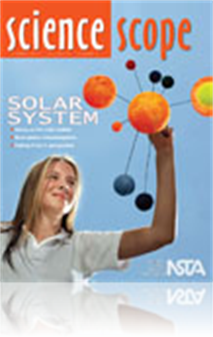All Science Scope resources
Journal Article
“May I go to the bathroom?” While this hardly an unusual question from any middle-level student, the number of students who suddenly need to leave the room increases when a teacher assigns a textbook passage to read. Whether it is to use the rest...
Journal Article
Erupting with Great Force: Performing Text to Enhance Reading Comprehension
Performing text in the form of choral reading, rap, reader’s theatre, and/or simulations offers students a powerful vehicle for understanding and recalling key concepts and significant details culled from textual materials. Creating a script, poem,...
Journal Article
President’s Message: Meeting the Needs of the New World Student
To succeed in the 21st century, students have to learn how to be creative problem solvers who can work in collaborative groups. These new-world students must have the ability to think critically, use technology efficiently, and communicate effectivel...
Journal Article
Reading Into Science: Making It Meaningful
Helping students read science textbooks and other substantive material does not have to interrupt the flow of content delivery. A variety of strategies, both instructive and effective, are available to help students become more competent and independ...
Journal Article
Through retelling, students can begin to attach sense and meaning to the sometimes complex concepts they encounter in science texts. Also, the shift from silent thinking to verbal expression causes the brain to consolidate and integrate new ideas. As...
Journal Article
Scope on Safety: Bloodborne pathogens—Be prepared, be protected
Malaria, Lyme disease, Epstein-Barr syndrome, meningitis, syphilis, hepatitis B and HIV/AIDS—what do all of these diseases have in common? These belong to a group of over 100 microorganisms categorized as bloodborne pathogens. With the HIV epidem...
Journal Article
Guest Editorial: Happy anniversary, traveling companion!
Fifty years ago, on Friday, October 4, 1957, a 184-pound, silver-colored, metal ball caused an event that would change the world forever and reshape science education in the United States for decades to come. That beach ball-sized object was the man-...
Journal Article
Editor’s Roundtable: Share your passion for science
We are not only teachers of science content, processes, and attitudes, but also teachers of writing and reading. The articles in this month’s issue of Science Scope contain numerous strategies to improve student achievement and understanding in s...
Journal Article
Science Sampler: Using direct instruction to teach content vocabulary
The magnitude of vocabulary students need to know in the middle school science curriculum is vast and can be daunting. As educators, it is our job to efficiently and effectively teach students so that they are not only able to apply the new vocabular...
Journal Article
Scope on the Skies: Between the planets
This year, Scope on the Skies will highlight members of our solar system, featuring current information about these objects and exploration missions to them. We will begin with an area of the solar system that could serve as a dividing line between t...
Journal Article
Science Sampler: Using trade books to improve science education
For students to be successful in science, they must be able to examine information, make predictions, and comprehend what they are reading (Miller 2006). By incorporating trade books, (such as fictional story books, informational story books, and inf...
Journal Article
Extreme Arthropods: Exploring Evolutionary Adaptations to Polar and Temperate Deserts
In this activity, Namib and Antarctic arthropods are used to illustrate several important biological principles. Among these are the key ideas that form follows function and that the environment drives evolution. In addition, students will discover t...
Journal Article
Although it is hard to claim that one or two school visits by a scientist will change how students think about science and their place in it, the authors’ experience suggests that, for many students, a school visit by a scientist makes a big and lo...




